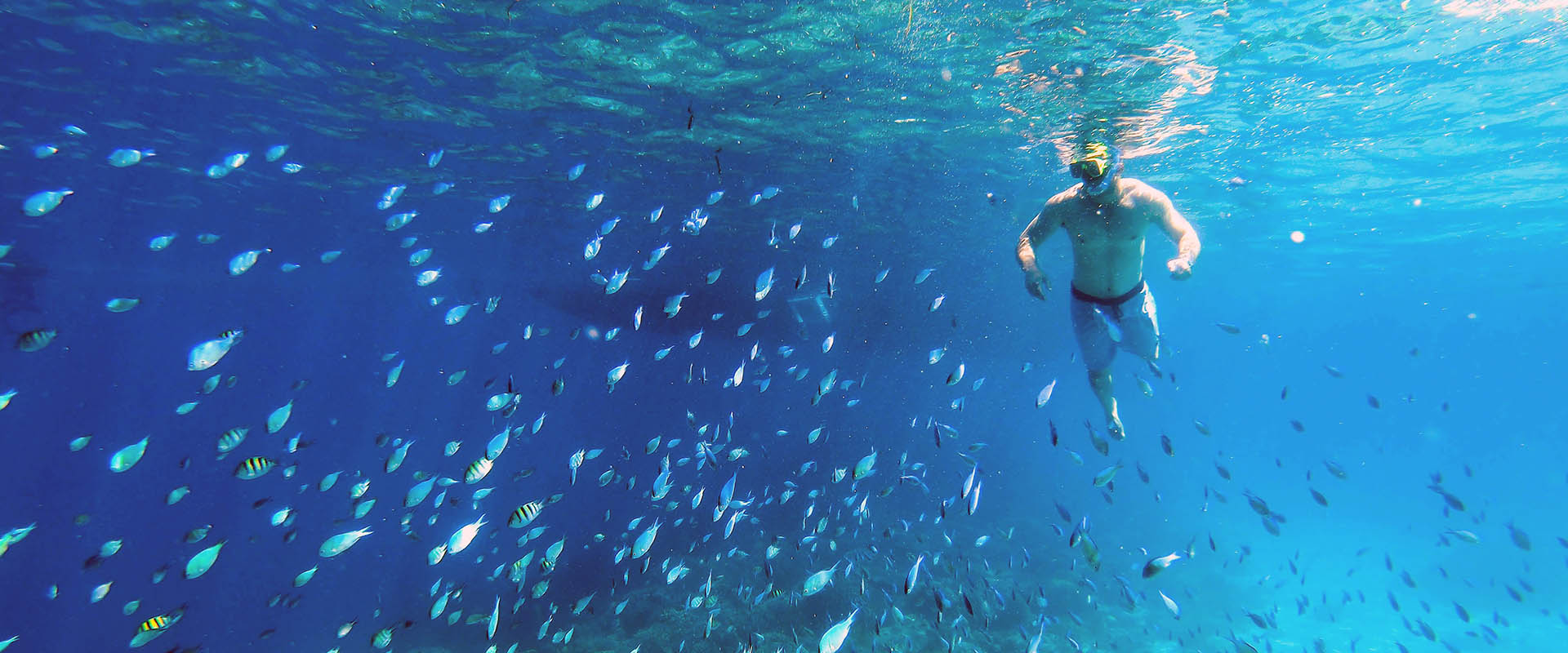Liveaboard Diving in Cebu
Liveaboard diving in Cebu
Liveaboards in Cebu offer divers a variety of choices for Philippines dive itineraries.Cebu, a long, thin island in the mid-east of the Philippines archipelago, is the leader of the Visayas and the location of the regional capital, Cebu City which means that many Philippines liveaboards leave from here. The Visayas is a huge area of cultural and ecological importance in the central-eastern part of the country. It holds the highest concentration and variety of the Philippines world-class dive sites, and many locations exhibit iconic Coral Triangle biodiversity of corals, fish, and invertebrates. Some of the most renowned Visayas dive locations are in Cebu. What's more, from this booming port, these dive sites are supremely accessible via a busy schedule of Cebu liveaboards departing year-round to different destinations.
Cebu liveaboard destinations
Up north, the idyllic island of Malapascua is a must-see for many liveaboard itineraries. This tiny island 6.8 km from the northern tip of Cebu is hugely famous for thresher sharks; itís the only place in the world where these deep-water swimmers can be seen daily. As if thatís not enough to recommend it, Malapascua also offers a large number of varied dive sites, and a laid-back island life without hustle, bustle, or cars. Liveaboards in Malapascua are the best way to combine the island with other top dive sites in the Visayas.
The top Malapascua dive site is Monad Shoal, Malapascuaís center-point, and crown jewel. This submerged island on the lip of a 200-meter drop-off brings denizens of the deep like threshers, manta rays, and devil rays up from their usual haunts to shallow cleaning stations, especially in the early morning. Shark Point and Shark Wall are the two main thresher dive spots. After Monad Shoal comes Gato Island, where at least five unique dive sites host a great diversity of creatures small and large, like sea snakes, tons of sharks, and pygmy seahorses. Kimud Shoal completes the holy trinity of top Malapascua dive sites; this is Malapascuas hammerhead shark destination. Liveaboards usually visit Malapascua for around three days before heading off to other destinations in Cebu and the greater Visayas.
Just next to Cebu City, literally a bus-ride away from the metropolis lies the premier liveaboard destination of Mactan island. This island is famous as the battleground where the European explorer Magellan lost his life to the warrior chief Lapu-Lapu. Now, however, visitors are welcome, and underwater offerings abound. Mactan dive sites include Olango Island, a protected area for birds, where whitetip sharks, barracuda, and even hammerheads can be seen. The currents here can be strong. However, beginners will have ample options for dive sites among Mactan's coral gardens, wrecks, walls, and caverns.
Cebu dive cruises often visit Mactan for just one day en route to other destinations. However, if you have extra time before or after your liveaboard, Mactan's many resorts and creature comforts make it a great base from which to continue world-class diving. When you're underwater, you'll feel like youíre miles away from civilization, but when you surface, youíll have the convenience of an international airport on the very same island.
Moalboal, pronounced mo-all bo-all, is an absolute must for many Cebu liveaboards. This is where the Philippines premier sardine run is located- a huge fish ball that moves at lightning pace to form and reform different shapes. Sometimes, divers here are lucky enough to see pelagic predators attracted by the food. Pescador island may be the dive site specified on liveaboard itineraries, but in recent years, the sardines have been seen not only on this small island just off the coast but immediately in front of the beach! Their new location allows even snorkelers to enjoy the sight.
Sailing in Cebu often means a visit Moalboal for just one day. However, some itineraries actually use Moalboal as a point of departure or disembarkation. Divers who want to relax on land for a few days and continue diving, or desire a waterfall trek or two, can make Moalboal a great base for their excursions. Land travel to Dumaguete is also easy for those who want an urban town vibe with good food and nice natural surroundings.
Sumilon island in the southeast of Cebu is famous as the very first marine protected area in the Philippines. It had a rocky past, having been dismantled, overfished, and then re-protected, but it remains a site where sharks and other great marine life can be seen. Cebu liveaboards often visit Sumilon island for a dive or two en route to Malapascua in the north or other islands like Negros, Siquijor, and Bohol in the south.
Itinerary details
The length of liveaboard itineraries in Cebu can be 6, 7, or 10 nights (the Siren offers 13 nights on a special transition dive trip from Palawan to Cebu), with budgets ranging from around 280 to 450 euros per night. These liveaboards usually combine dive locations in Cebu with dive locations on other islands of the Visayas, like Negros, Bohol, Siquijor, or Southern Leyte. Camiguin is also sometimes included, though this island is technically part of Mindanao. Liveaboards in Cebu range from the super luxurious S/Y Siren with its billowing sails to refurbished merchant vessels and dedicated M/V diving yachts- all enjoy different degrees of luxury, but consistently offer great diving amenities.
The experience level required by Cebu liveaboards is generally Open Water, with either ten or twenty dives, depending on the itinerary. The exceptions to the rule are one dive tour on Solitude One requiring Advanced Open Water and 50 logged dives. Select dive sites in the Philippines definitely experience current, but the country is not as infamous for fast-moving water as the Maldives or Indonesia. Youíll depends on your dive guide to advise you of any particular challenges or experience requirements at a given site. Note that Monad Shoal in Malapascua, where the threshers can be seen, is an advanced site with currents where divers usually use nitrox.
Liveaboard departures
Cebu City, Malapascua, and Moalboal are all liveaboard departure locations in Cebu. Getting to Cebu City is easy with a 1.5-hour flight from Manila or direct flights from select Southeast Asian countries nearby. International flights can get to Cebu City via a transfer in Asia. Malapascua, on the other hand, has no airport, but it can be reached by taxi, van, or bus (and small boat). From Cebu City, getting to Malapascua requires a five-hour bus journey; taxis take about half that time. Getting to Moalboal from Cebu City requires a shorter bus journey, first over the mountains to the west side of the island, and then south a bit.
Best time to travel
Philippines liveaboards from Cebu can be dived all year round, though we don't recommend the most typhoon-likely months of late November through January. The regional rainy season of July through December does affect dive sites, but the amount of rainfall varies widely depending on the exact location. For example, Malapascua's separation from the mainland and mountain ranges means that rain is less frequent. Waves and wind correspond with either the northeast or southwest monsoons, but there is always somewhere sheltered to dive. In terms of wildlife, Malapascua's thresher sharks and whitetip sharks are present year-round, but hammerheads peak in March or April, and mantas usually peak around September. The water temperature varies in Cebu, with a low around 24 in the winter at deep dive sites, and a high of 30 C. 27-30 C is more often the range in many places.
Cebu Diving Reviews
- 9.2 Superb
- 8.8 Fabulous
- Philip P
United States
Whale sharks were interesting.
Diving Cebu in September on the Philippine Siren
- 9.6 Exceptional
- linda P
United States
varied and appropriate for all levels of divers healthy reefs ,lots of fish varies dive sites warm water gentle currents
Diving Cebu in October on the Philippine Siren
- 10.0 Exceptional
- Damien T
France
Haunted island :several turtles
Diving Cebu in February on the Infiniti
- 10.0 Exceptional
- Juan David B
Colombia
Excellent, extremely healthy and endless coral gardens, but I was expecting big creatures. This is not a big creatures itinerary.
Diving Cebu in January on the Philippine Siren
- 7.2 Good
- Jean-Francois C
France
The initial program has been modified due to weather. All the dives were full of coral garden, fishes.
Diving Cebu in February on the Seadoors
- 8.8 Fabulous
- Desmond L
Canada
During the bad weather , nothing we would have expected. But still acceptable because the boat director route selected .
Diving Cebu in July on the Philippine Siren
- 9.6 Exceptional
- Carsten N
Germany
Das Tauchen in Oslob mit den Walhaien ist ein Erlebnis. Die Walhaie haben keine Scheu. Ein junger Walhai folgte unserer Gruppe zum Boot und wir hatten den furchtlosen jungen Walhai ständig um uns herum.
Diving Cebu in November on the Seadoors











